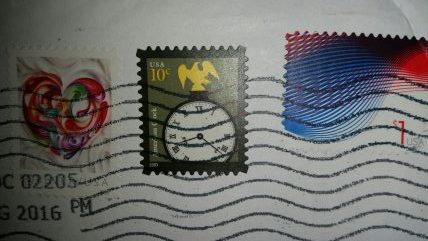Print newsletter vs. e-newsletter for financial marketers
Should you send a print newsletter or an e-newsletter? I’m asking this question because I just added a 28-page paper newsletter to my “to read” pile. This newsletter wouldn’t have commanded my attention if it had come via email. While newsletters printed on paper and sent via the postal service are becoming dinosaurs, you may find them worthwhile.
The case for a print newsletter
The big reason to send a print newsletter is to break through the clutter encountered by e-newsletters. I have e-mail inbox rules that move most e-newsletters into a folder called “newsletter.” I rarely read them. I even skip newsletters that would interest or help me because there are too many of them.
Marketing via mail generally achieves higher response rates. According to “2015 DMA Response Rate Report: Direct Mail Outperforms All Digital Channels Combined By Nearly 600%“:
Direct mail achieves a 3.7% response rate with a house list, and a 1.0% response rate with a prospect list. All digital channels combined only achieve a 0.62% response rate (Mobile 0.2%; Email 0.1% for a Prospect list and 0.1% for House/Total list; Social Media 0.1%; Paid Search 0.1%; Display Advertising 0.02%).
Direct mail’s 3.7% and 1.0% response rates for house lists and prospect lists respectively look attractive compared with the 0.1% response rates for email. Of course, your experience may differ from the DMA’s results.
Another plus of print is your control of what readers see in front of their eyes. This contrasts with e-newsletters, where readers’ email programs or browsers may distort your layout or blank out images.
The case against a print newsletter

Stamps on the envelope of the 28-page newsletter that inspired this post
I see three main drawbacks to print newsletters: cost, timeliness, and lack of analytics.
It’s relatively expensive to send a print newsletter via the U.S. mail. A $1.57 worth of stamps adorned the newsletter I just opened. Other costs may include envelopes, paper (fancy stock is pricey), ink, and design work. Only design work might apply to an e-newsletter, though you may also need to pay for an e-mail marketing provider, such as Constant Contact or MailChimp.
Taking a contrary view on cost, “2015 DMA Response Rate Report: Direct Mail Outperforms All Digital Channels Combined By Nearly 600%” argues that direct mail’s costs are competitive with other media, perhaps partly because of print’s higher response rates. Here’s the article’s take on costs:
Cost-per-acquisition for direct mail is very competitive. Direct mail stands at $19, which fares favorably with Mobile and Social Media (both at $16-18), Paid Search ($21-30), Internet Display ($41-50) and even email ($11-15).
Print newsletters take longer than e-newsletters to reach your readers. That’s partly a function of the creation process, especially if an outside designer or printer is involved. Plus, you must give your newsletters to the post office and wait for their delivery.
Unlike e-newsletters, print newsletters don’t give you detailed analytics. You can’t see who opened your newsletter or which content attracted the most attention.
Use both instead of only a print newsletter
Enjoy some of the benefits of both printed and electronic communications by using both formats, if your budget permits.
For example, like the person who sent me the 28-page newsletter, you can email your list about with teaser copy about your printed newsletter. You can also include a link to an online version of your paper newsletter.
Another possibility: use print for your regular newsletters and use e-newsletters for more time-sensitive communications.
What are your results?
If you’ve used both a print newsletter and an e-newsletter, how do your results compare? Would you recommend one over the other? I enjoy learning from you.
Dinosaur image courtesy of Geerati/FreeDigitalPhotos.net




We use both printed and email and they work great. You are correct in that virtually no one sends printed anything any longer so it helps you stand out if you do it right. I have a undergrad in graphic design so it has helped our firm create a newsletter that stands out versus your typical financial advisor newsletter.
If you decide to do a print newsletter the key is to do it right. Work with a designer and have it printed in high quality on nice paper. It shows poorly of your firm if you send out anything to the contrary.
Also, I serve on the board of an organization that sends both printed and email communications to prospective clients and, I suppose not surprising based on this article, they get a much higher response rate from print communications. Very interesting.
Jeremy, thank you for sharing your experience and helpful tips!